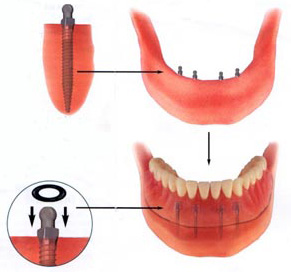Dental Implants
There have been much advancement in dentistry over the years and one of the most notable is dental implants. Replacing missing teeth is important, not only for your appearance, self-confidence and full mouth function, but also for retaining total oral health. Dental implants are made from medical grade titanium and resemble a thread or screw. What makes an implant such an ideal restorative solution is its ability to mimic the function of a natural tooth root and integrate with your jawbone in a relatively short time frame. The surgery and placement of the implant is performed at Mascot Dental, providing you with a permanent solution for restoring your smile.
Dental implants are titanium screws which are surgically placed into your jawbone, to which a crown can be attached once the implant completely bonds with your bone. Dental implants could be an ideal solution for the replacement of one or several missing teeth.
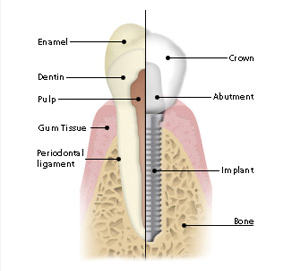
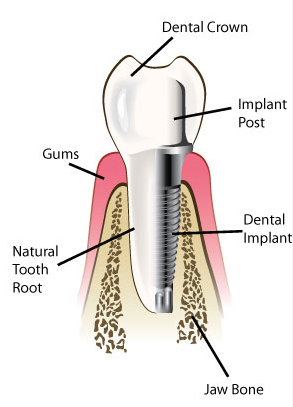
Dental implants act as an artificial tooth root that is securely anchored into the jawbone, to which dental work such as a crown, fixed bridge or a full set of dentures can be added to replace missing teeth. Made from a very strong, biocompatible material, dental implants are placed in a simple procedure that is usually no more complicated than a tooth extraction. Your new implant is then left buried in your jaw bone for a period of healing, left undisturbed under the gum tissue. It is then uncovered and connected to the small metal post which will secure and supports your new artificial tooth.
Depending on where the implant is placed into your jaw, this process can take from a few months to over 9 months. As a rule, implants in the front lower jaw will need around 4 months; in your back upper jaw they will need around 9 months, and around 6 months in other places in the mouth, although the process of getting dental implants will take longer if you need bone grafting. A dental implant is the closest thing to a natural tooth replacement, feeling much more natural and secure than traditional removable dentures, especially if you have lost a lot of jaw bone. Importantly, At Mascot Dental Centre implants will allow us to replace a missing tooth without needing to modify your adjacent teeth.
Implant is requiring just two appointments, implant dentistry requires just a small incision in your gum to allow the titanium implant to be gently guided to your jawbone. With local anaesthetic, you are completely comfortable throughout the procedure, and in fact, many of our patients return to their normal daily routine the following day.
A period of around 3-6 months after surgical placement is required for your natural bone to adhere to the titanium implant screw. During this time a temporary crown or bridge is placed so you are able to retain your full smile.
When the bone has sufficiently adhered to the implant your temporary teeth are then removed and your new crown or bridge is permanently secured to the implant. This is not only rejuvenates your smile and improves your quality of life with an extremely strong, long lasting and successful option to replace missing or broken down teeth.With dental implants you can once again experience the great feeling of a complete smile that is secure, stable and reliable.
Advantages of Dental implants are
- Implants help to withstand greater bite pressure and prevent bone loss in the jaw.
- Implants prevent the formation of hollowed or collapsed cheeks that can occur after tooth extraction.
- Implants are usually surrounded by gum tissue like natural teeth and may prevent gum recession.
- Implants unlike bridges, to not require cutting or shaping of the natural teeth around it, and are firmly secured in the jaws.
- Implants are usually more comfortable than dentures and usually do not require separate care routines or special cleaning products, implants like natural teeth, are clean by dental floss and brushing with regular toothpaste.
- Implants allow conservative management of spaces between teeth, preventing the dentist from having to sacrifice adjacent teeth to support a prosthesis, such as a bridge. Single tooth implants restore your teeth to complete function and aesthetics and are the best long term replacement of a missing tooth. Single tooth implants have a 98.9% success rate at 10 years post placement.
- They provide rigid support for the overlying crown, bridge or over-denture to attach onto and function for the long term.
- Implants importantly allow for the precious preservation of the underlying jaw bone. The presence of an implant will initiate bone remodelling of the space and preserve the bone. The implant stimulates the bone back into production, where once it lay dormant and for some people there is insufficient bone for implant placement. If you leave the space too long, there may be insufficient bone to place an implant. In this instance augmentation procedures will be required prior too, or during implant placement.
- There is a high demand for implant supported over-dentures. Long standing denture wearer’s has difficulty in stabilising the lower denture due to often severe bone reportion. Placing up-to five (5) implants in the lower jaw can fully retain and support an immovable lower over denture.
Dental Implant Procedure
Different types of implants are available. Most implants are made from titanium.
In most cases, the dental implant procedure involves three separate stages:
- Insertion of implant into the bone
- Insertion of the abutment on the implant
- Attachment of the artificial tooth to the abutment
The surgical process can take from 30minutes to several hours. The whole process may take from 3-6months from insertion of implant to fitting of the crown.
- Preparation of Implant Hole – the dentist prepares a site in the gum to expose the underlying bone. A drill prepares a hole in the jawbone.
- Insertion of the Implant – the implant is cylindrical and its surface is either threaded or smooth. It is inserted into position in the hole and the gums are stitched closed. Stitches are removed 7-10 days after. Implant stability improves over the weeks and months as bone tissue grows on the surface of the implant. The dentist may allow up to six months for your bone to integrate with the implant.
- Insertion of Abutment – the abutment is fitted after the bone has healed. The abutment is the support post between the implant and the crown. The dentist makes an incision into the gum to access the implant. X-rays are used to ensure the abutment is correctly placed. A dental impression of your mouth may be taken to finalize the design of the crown. The dentist may allow a few weeks for the gum to heal.
- Attachment of the artificial tooth – the dentist checks the implant is strong enough to support the forces exerted by the artificial tooth. If so, the tooth is attached either by cement, or by screw. You may choose to have detachable implants. These are known as ‘over-dentures’; they are not as sturdy but are easy to clean. Once the artificial tooth is attached, an x-ray may be taken to ensure correct placement of everything.
- Dentures – instead of an artificial tooth, an implant can be fitted with special clips or attachments that firmly hold an existing denture in position. The aim is to improve the stability of the denture.
Recovery
- Arrange to be driven home by someone
- Some people take a few days off work
- Do not operate heavy machine
- Do not engage in strenuous activity
- Swelling, bruising, mouth pain and head ache are normal reactions that usually subside within one week
- Ice packs can help reduce swelling
- You may be prescribed antibiotics
- Drink plenty of fluids
- Avoid alcohol and smoking
- Eat soft foods
- Rinsing your mouth with warm salt water can help with healing
- Follow up appointments ensure with ongoing success
- See your dentist is swelling or pain persists
- Good oral hygiene is important
Oral Hygiene for Dental Implants
Bacteria in the mouth forms plaque that can adhere to natural and artificial teeth. Your implants may fail if they are not kept clean; this may cause gum disease and infection. General suggestions:
- Brush teeth after every meal
- Clean every surface or every tooth
- Use fluoride toothpaste to reduce risk of decay
- Use interdental brushes
- Floss at least once daily
- Do not smoke
- Limit your intake of sugary foods and drinks
- See your dentist immediately if you have tooth or gum pain
Complications of Dental Implant Treatment
- Allergies – people may have allergic reactions to anaesthetics or the materials used in the implant, albunator or crown
- Vomiting – some people vomit during recovery of anaesthesia
- Affected sinus – an implant inserted into the upper jaw may contact or perforate the sinus within the bone and cause infection. Antibiotics are used to treat the infection.
- Fractured lower jaw – rarely, the lower jaw may break during the procedure
- Damaged nerve – the inferior dental nerve runs the length of the lower jaw. Placement of an implant may damage this nerve and cause numbness in the gums, lips or skin around the mouth. In most cases, this will resolve within 18 months.
- Inhaling or swallowing equipment parts – the patient may accidently inhale or swallow a piece of equipment. This may cause breathing problems or infection. Surgery may be needed to remove it.
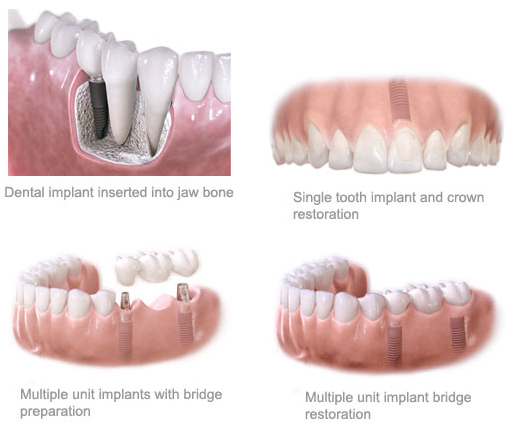
- Speech problems – some patients have speech problems following the fitting of an implant. This usually resolves once the patient gets used to the altered feel of the mouth.
- Gum tissue overgrowth (hyperplasia) – the gum surrounding the implant may enlarge and push above the gum line causing redness and pain. This can be reversed with good oral hygiene or can be surgically removed.
- Infection – the area around the implant may become infected; this can be resolved with antibiotics. In certain people, implants can lead to infection in other areas other than the implant site. Infectious endocarditis is a potentially life threatening infection of the heart. People who have undergone prior heart surgery are at risk of this rare complication
- Bone loss – in most cases, the pressure of biting and chewing encourages strong bone tissue to grow around the implant. In rare cases, the implant causes bone loss, and the implant eventually becomes unstable.
- Loose implant – the implant may fail to integrate with the bone or it may become unstable with time. The implant must be removed and another inserted into the jaw nearby. Alternatively, the bone is allowed to heal and an implant is inserted into the same place.
- Loose tooth – the artificial tooth may come loose from the abutment, or the abutment may become loose from the implant
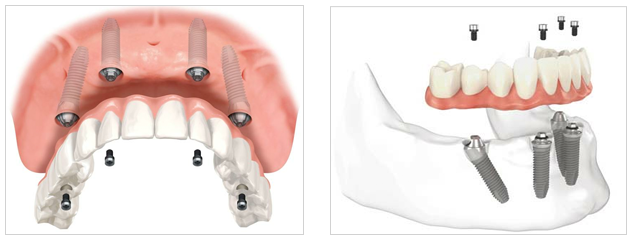
Implant Supported Denture
An implant-supported denture is a type of over denture that is supported by and attached to implants. A regular denture rests on the gums, and is not supported by implants.
An implant-supported denture is used when a person doesn’t have any teeth in the jaw, but has enough bone in the jaw to support implants. An implant-supported denture has special attachments that snap onto attachments on the implants.
Implant-supported dentures usually are made for the lower jaw because regular dentures tend to be less stable there. Usually, a regular denture made to fit an upper jaw is quite stable on its own and doesn’t need the extra support offered by implants. However, you can receive an implant-supported denture in either the upper or lower jaw.
You should remove an implant-supported denture daily to clean the denture and gum area. Just as with regular dentures, you should not sleep with the implant-supported dentures at night. Some people prefer to have fixed (permanent) crown and bridgework in their mouths that can’t be removed. Your dentist will consider your particular needs and preferences when suggesting fixed or removable options.
Implant-supported dentures: bar-retained and ball-retained. In both cases, the denture will be made of an acrylic base that will look like gums. Porcelain or acrylic teeth that look like natural teeth are attached to the base. Both types of dentures need at least two implants for support.
- Bar-retained dentures — a thin metal bar that follows the curve of your jaw is attached to two to five implants that have been placed in your jawbone. Clips or other types of attachments are fitted to the bar, the denture or both. The denture fits over the bar and is securely clipped into place by the attachments.
- Ball-retained dentures (stud-attachment dentures) — each implant in the jawbone holds a metal attachment that fits into another attachment on the denture. In most cases, the attachments on the implants are ball-shaped (“male” attachments), and they fit into sockets (“female” attachments) on the denture. In some cases, the denture holds the male attachments and the implants hold the female ones. the following is the other type of ball retained dentures.(Mini Implant)
Mini Implant
How are the MDI Mini Implants placed?
Placement of the implant is accomplished quickly and easily in a process performed in the dentist’s office, with local anaesthesia. Using a precise, controlled and minimally invasive surgical technique MDI implants are placed in the jawbone. The heads of the implants protrude from the gum tissue and provide a strong, solid foundation for securing your artificial crown 2 weeks later. Because of the minimally invasive nature of this procedure, MDI placement doesn’t require a lengthy healing period, meaning impression for crown can be taken the same day the mini implants are placed, and your crown can be issued 2 weeks later.
